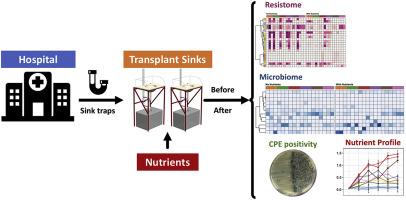当前位置:
X-MOL 学术
›
Water Res.
›
论文详情
Our official English website, www.x-mol.net, welcomes your
feedback! (Note: you will need to create a separate account there.)
Nutrients influence the dynamics of Klebsiella pneumoniae carbapenemase producing enterobacterales in transplanted hospital sinks.
Water Research ( IF 11.4 ) Pub Date : 2020-03-13 , DOI: 10.1016/j.watres.2020.115707 Shireen Meher Kotay 1 , Hardik I Parikh 1 , Katie Barry 1 , Hyun Soon Gweon 2 , William Guilford 3 , Joanne Carroll 4 , Amy J Mathers 5
Water Research ( IF 11.4 ) Pub Date : 2020-03-13 , DOI: 10.1016/j.watres.2020.115707 Shireen Meher Kotay 1 , Hardik I Parikh 1 , Katie Barry 1 , Hyun Soon Gweon 2 , William Guilford 3 , Joanne Carroll 4 , Amy J Mathers 5
Affiliation

|
Antimicrobial resistance has been recognized as a threat to human health. The role of hospital sinks acting as a reservoir for some of the most concerning antibiotic resistant organisms, carbapenemase producing Enterobacterales (CPE) is evident but not well understood. Strategies to prevent establishment, interventions to eliminate these reservoirs and factors which drive persistence of CPE are not well established. We use a uniquely designed sink lab to transplant CPE colonized hospital sink plumbing with an aim to understand CPE dynamics in a controlled setting, notably exploiting both molecular and culture techniques. After ex situ installation the CPE population in the sink plumbing drop from previously detectable to undetectable levels. The addition of nutrients is followed by a quick rebound in CPE detection in the sinks after as many as 37 days. We did not however detect a significant shift in microbial community structure or the overall resistance gene carriage in longitudinal samples from a subset of these transplanted sinks using whole shotgun metagenomic sequencing. Comparing nutrient types in a benchtop culture study model, protein rich nutrients appear to be the most supportive for CPE growth and biofilm formation ability. The role of nutrients exposure is determining factor for maintaining a high bioburden of CPE in the sink drains and P-traps. Therefore, limiting nutrient disposal into sinks has reasonable potential with regard to decreasing the CPE wastewater burden, especially in hospitals seeking to control an environmental reservoir.
中文翻译:

营养物影响肺炎克雷伯菌肺炎克雷伯菌酶在医院水槽中产生肠杆菌的动力学。
抗菌素耐药性已被视为对人类健康的威胁。医院水槽作为一些最相关的抗生素抗性生物(产生碳青霉烯酶的肠杆菌(CPE))的储库所起的作用是显而易见的,但尚未广为人知。防止建立的策略,消除这些水库的干预措施以及导致CPE持久性的因素还没有很好地确定。我们使用设计独特的水槽实验室来移植CPE殖民化的医院水槽管道,旨在了解可控环境中CPE的动态,特别是利用分子和培养技术。异地安装后,水槽管道中的CPE数量从先前可检测的水平下降到不可检测的水平。添加营养后,多达37天后,水槽中CPE的检测迅速反弹。但是,我们未使用整体shot弹枪宏基因组测序从这些移植后的子集的纵向样本中检测到微生物群落结构或总体抗性基因携带的显着变化。在台式培养研究模型中比较养分类型,富含蛋白质的养分似乎最支持CPE生长和生物膜形成能力。养分暴露的作用是在水槽下水道和P型阱中维持高CPE生物负荷的决定因素。因此,在减少CPE废水负担方面,将营养物限制在水槽中具有合理的潜力,尤其是在寻求控制环境水库的医院中。但是,我们没有使用完整的散弹枪宏基因组测序从这些移植的水槽子集的纵向样品中检测到微生物群落结构或总体抗性基因携带的显着变化。在台式培养研究模型中比较养分类型,富含蛋白质的养分似乎最支持CPE生长和生物膜形成能力。养分暴露的作用是在水槽下水道和P型阱中维持高CPE生物负荷的决定因素。因此,在减少CPE废水负担方面,将营养物限制在水槽中具有合理的潜力,尤其是在寻求控制环境水库的医院中。但是,我们没有使用完整的散弹枪宏基因组测序从这些移植的水槽子集的纵向样品中检测到微生物群落结构或总抗性基因携带的显着变化。在台式培养研究模型中比较养分类型,富含蛋白质的养分似乎最支持CPE生长和生物膜形成能力。营养物质暴露的作用是在水槽下水道和P型阱中维持高CPE生物负荷的决定因素。因此,在减少CPE废水负担方面,限制营养物进入水槽具有合理的潜力,尤其是在寻求控制环境水库的医院中。
更新日期:2020-03-16
中文翻译:

营养物影响肺炎克雷伯菌肺炎克雷伯菌酶在医院水槽中产生肠杆菌的动力学。
抗菌素耐药性已被视为对人类健康的威胁。医院水槽作为一些最相关的抗生素抗性生物(产生碳青霉烯酶的肠杆菌(CPE))的储库所起的作用是显而易见的,但尚未广为人知。防止建立的策略,消除这些水库的干预措施以及导致CPE持久性的因素还没有很好地确定。我们使用设计独特的水槽实验室来移植CPE殖民化的医院水槽管道,旨在了解可控环境中CPE的动态,特别是利用分子和培养技术。异地安装后,水槽管道中的CPE数量从先前可检测的水平下降到不可检测的水平。添加营养后,多达37天后,水槽中CPE的检测迅速反弹。但是,我们未使用整体shot弹枪宏基因组测序从这些移植后的子集的纵向样本中检测到微生物群落结构或总体抗性基因携带的显着变化。在台式培养研究模型中比较养分类型,富含蛋白质的养分似乎最支持CPE生长和生物膜形成能力。养分暴露的作用是在水槽下水道和P型阱中维持高CPE生物负荷的决定因素。因此,在减少CPE废水负担方面,将营养物限制在水槽中具有合理的潜力,尤其是在寻求控制环境水库的医院中。但是,我们没有使用完整的散弹枪宏基因组测序从这些移植的水槽子集的纵向样品中检测到微生物群落结构或总体抗性基因携带的显着变化。在台式培养研究模型中比较养分类型,富含蛋白质的养分似乎最支持CPE生长和生物膜形成能力。养分暴露的作用是在水槽下水道和P型阱中维持高CPE生物负荷的决定因素。因此,在减少CPE废水负担方面,将营养物限制在水槽中具有合理的潜力,尤其是在寻求控制环境水库的医院中。但是,我们没有使用完整的散弹枪宏基因组测序从这些移植的水槽子集的纵向样品中检测到微生物群落结构或总抗性基因携带的显着变化。在台式培养研究模型中比较养分类型,富含蛋白质的养分似乎最支持CPE生长和生物膜形成能力。营养物质暴露的作用是在水槽下水道和P型阱中维持高CPE生物负荷的决定因素。因此,在减少CPE废水负担方面,限制营养物进入水槽具有合理的潜力,尤其是在寻求控制环境水库的医院中。











































 京公网安备 11010802027423号
京公网安备 11010802027423号